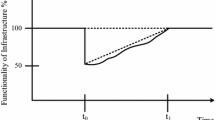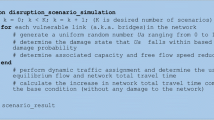Abstract
With the development of economic globalization and increasing international trade, the maritime transportation system (MTS) is becoming more and more complex. A failure of any supply line in the MTS can seriously affect the operation of the system. Resilience describes the ability of a system to withstand or recover from a disaster and is therefore an important method of disaster management in MTS. This paper analyzes the impact of disasters on MTS, using the data of Suez Canal "Century of Congestion" as an example. In practice, the severity of a disaster is dynamic. This paper categorizes disasters into different levels, which are then modelled by the Markov chain. The concept of a repair line set is proposed and is determined with the aim to minimize the total loss and maximize the resilience increment of the line to the system. The resilience measure of MTS is defined to determine the repair line sequence in the repair line set. Finally, a maritime transportation system network from the Far East to the Mediterranean Sea is used to validate the applicability of the proposed method.














Similar content being viewed by others
Notes
References
Adjetey-Bahun, K., Birregah, B., Chatelet, E., & Planchet, J. L. (2016). A model to quantify the resilience of mass railway transportation systems. Reliability Engineering and System Safety, 153, 1–14. https://doi.org/10.1016/j.ress.2016.03.015
Allenby, B., & Fink, J. (2005). Toward inherently secure and resilient societies. Science, 309(5737), 1034–1036. https://doi.org/10.1126/science.1111534
Asadabadi, A., & Miller-Hooks, E. (2020). Maritime port network resiliency and reliability through co-opetition. Transportation Research Part E Logistics and Transportation Review, 137, 101916. https://doi.org/10.1016/j.tre.2020.101916
Bai, G. H., Wang, H., Zheng, X. Q., Dui, H. Y., & Xie, M. (2021). Improved resilience measure for component recovery priority in power grids. Frontiers of Engineering Management, 8(4), 545–556. https://doi.org/10.1007/s42524-021-0161-5
Bao, S., Zhang, C., Ouyang, M., & Miao, L. X. (2019). An integrated tri-level model for enhancing the resilience of facilities against intentional attacks. Annals of Operations Research, 283(1–2), 87–117. https://doi.org/10.1007/s10479-017-2705-y
Barker, K., Ramirez-Marquez, J. E., & Rocco, C. M. (2013). Resilience-based network component importance measures. Reliability Engineering and System Safety, 117, 89–97. https://doi.org/10.1016/j.ress.2013.03.012
Berle, O., Asbjornslett, B. E., & Rice, J. B. (2010). Formal Vulnerability Assessment of a maritime transportation system. Reliability Engineering and System Safety, 96(6), 696–705. https://doi.org/10.1016/j.ress.2010.12.011
Birnbaum, Z. W. (1969). On the importance of different components in a multicomponent system. In Multivariate analysis, II. Proceedings of the 2nd international symposium on, Dayton, Ohio, 1968 (pp. 581–592), New York: Academic Press.
Caldera, H. J., & Wirasinghe, S. C. (2022). A universal severity classification for natural disasters. Natural Hazards, 111, 1533–1573. https://doi.org/10.1007/s11069-021-05106-9
Chen, M. C., Zhao, X. F., & Nakagawa, T. (2019). Replacement policies with general models. Annals of Operations Research, 277(1), 47–61. https://doi.org/10.1007/s10479-017-2685-y
Cimellaro, G. P., Reinhorn, A. M., & Bruneau, M. (2010). Framework for analytical quantification of disaster resilience. Engineering Structures, 32(11), 3639–3649. https://doi.org/10.1016/j.engstruct.2010.08.008
de Boer, J. (1990). Definition and classification of disasters: Introduction of a disaster severity scale. The Journal of Emergency Medicine, 8(5), 591–595. https://doi.org/10.1016/0736-4679(90)90456-6
Dinh, L., Pasman, H., Gao, X. D., & Mannan, M. S. M. (2012). Resilience engineering of industrial processes: Principles and contributing factors. Journal of Loss Prevention in the Process Industries, 25(2), 233–241. https://doi.org/10.1016/j.jlp.2011.09.003
Dui, H. Y., Zheng, X. Q., & Wu, S. M. (2021). Resilience analysis of maritime transportation systems based on importance measures. Reliability Engineering and System Safety, 209(6), 107461. https://doi.org/10.1016/j.ress.2021.107461
Holling, C. S. (1973). Resilience and stability of ecological systems. Annual Review of Ecology & Systematics, 4(1), 1–23. https://doi.org/10.1146/annurev.es.04.110173.000245
Hosseini, S., Barker, K., & Ramirez-Marquez, J. E. (2016). A review of definitions and measures of system resilience. Reliability Engineering and System Safety, 145, 47–61. https://doi.org/10.1016/j.ress.2015.08.006
Jufri, F. H., Widiputra, V., & Jung, J. (2019). State-of-the-art review on power grid resilience to extreme weather events: Definitions, frameworks, quantitative assessment methodologies, and enhancement strategies. Applied Energy, 239, 1049–1065. https://doi.org/10.1016/j.apenergy.2019.02.017
Madni, A. M., & Jackson, S. (2009). Towards a conceptual framework for resilience engineering. IEEE Systems Journal, 3(2), 181–191. https://doi.org/10.1109/JSYST.2009.2017397
Mohammed, A., Harris, I., Soroka, A., Naim, M., Ramjaun, T., & Yazdani, M. (2020). Gresilient supplier assessment and order allocation planning. Annals of Operations Research, 296(1–2), 335–362. https://doi.org/10.1007/s10479-020-03611-x
Ouyang, M., & Wang, Z. (2015). Resilience assessment of interdependent infrastructure systems: With a focus on joint restoration modeling and analysis. Reliability Engineering & System Safety, 141, 74–82. https://doi.org/10.1016/j.ress.2015.03.011
Ross, S. M. (1996). Stochastic processes (2nd ed.). Wiley.
Sheu, S. H., Liu, T. H., Zhang, Z. G., Zhao, X. F., & Chieh, Y. H. (2021). A generalized age-dependent minimal repair with random working times. Computers & Industrial Engineering, 156, 107248. https://doi.org/10.1016/j.cie.2021.107248
Si, S. B., & Levitin, G. (2013). Component state-based integrated importance measure for multi-state systems. Reliability Engineering and System Safety, 116, 75–83. https://doi.org/10.1016/j.ress.2013.02.023
Verschuur, J., Koks, E. E., & Hall, J. W. (2020). Port disruptions due to natural disasters: Insights into port and logistics resilience. Transportation Research Part D Transport and Environment, 85, 102393. https://doi.org/10.1016/j.trd.2020.102393
Wan, C. P., Yan, X. P., Zhang, D., Qu, Z. H., & Yang, Z. L. (2019). An advanced fuzzy Bayesian-based FMEA approach for assessing maritime supply chain risks. Transportation Research Part e: Logistics and Transportation Review, 125, 222–240. https://doi.org/10.1016/j.tre.2019.03.011
Woods, D. D. (2015). Four concepts for resilience and the implications for the future of resilience engineering. Reliability Engineering and System Safety, 141, 5–9. https://doi.org/10.1016/jress.2015.03.018
Yodo, N., & Wang, P. F. (2016). Engineering resilience quantification and system design implications: A literature survey. Journal of Mechanical Design, 138(11), 111408. https://doi.org/10.1115/1.4034223
Youn, B. D., Hu, C., & Wang, P. (2011). Resilience-driven system design of complex engineered systems. Journal of Mechanical Design, 133(10), 101011. https://doi.org/10.1115/1.4004981
Zeng, Z. G., Fang, Y. P., Zhai, Q. Q., & Du, S. J. (2021). A Markov reward process-based framework for resilience analysis of multistate energy systems under the threat of extreme events. Reliability Engineering and System Safety, 209, 107443. https://doi.org/10.1016/j.ress.2021.107443
Zhang, P., & Li, N. (2014). The standardization of natural disasters risk grading methods in China. Journal of Catastrophology, 29(2), 60–64. https://doi.org/10.3969/j.issn.1000-811X.2014.02.013.
Zhao, X. F., Chen, M. C., & Nakagawa, T. (2020b). Periodic replacement policies with shortage and excess costs. Annals of Operations Research, 311(1), 469–487. https://doi.org/10.1007/s10479-020-03566-z
Zhao, X. F., Mizutani, S., Chen, M. C., & Nakagawa, T. (2020a). Preventive replacement policies for parallel systems with deviation costs between replacement and failure. Annals of Operations Research, 312(1), 533–551. https://doi.org/10.1007/s10479-020-03791-6
Funding
This study was funded by the National Natural Science Foundation of China (Nos. 72071182, U1904211), the Key Science and Technology Program of Henan Province (No. 222102520019), the Program for Science & Technology Innovation Talents in Universities of Henan Province (No. 22HASTIT022), and the Program for young backbone teachers in Universities of Henan Province (No. 2021GGJS007).
Author information
Authors and Affiliations
Contributions
Hongyan Dui and Shaomin Wu proposed the idea of this paper; Hongyan Dui and Kaixin Liu performed the experiments and analyzed the data; Hongyan Dui and Shaomin Wu revised the methodology and model; All authors have contributed to the writing, editing and proofreading of this paper.
Corresponding author
Ethics declarations
Conflict of interest
The authors report no conflict of interest and have received no payment in preparation of this manuscript.
Ethical approval
This article does not contain any studies with human participants or animals performed by any of the authors.
Additional information
Publisher's Note
Springer Nature remains neutral with regard to jurisdictional claims in published maps and institutional affiliations.
Rights and permissions
Springer Nature or its licensor (e.g. a society or other partner) holds exclusive rights to this article under a publishing agreement with the author(s) or other rightsholder(s); author self-archiving of the accepted manuscript version of this article is solely governed by the terms of such publishing agreement and applicable law.
About this article
Cite this article
Dui, H., Liu, K. & Wu, S. Data-driven reliability and resilience measure of transportation systems considering disaster levels. Ann Oper Res (2023). https://doi.org/10.1007/s10479-023-05301-w
Accepted:
Published:
DOI: https://doi.org/10.1007/s10479-023-05301-w




